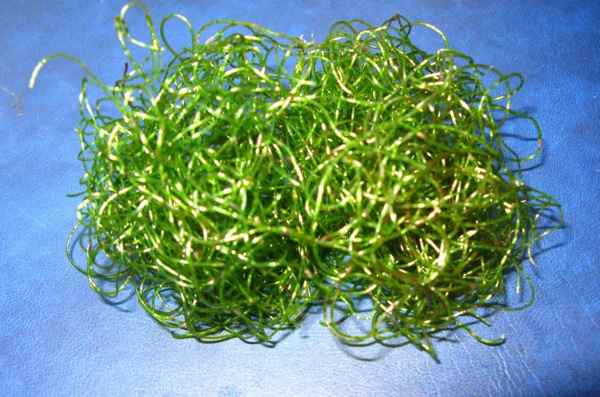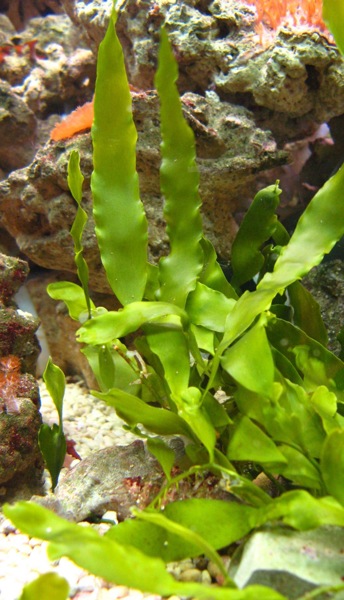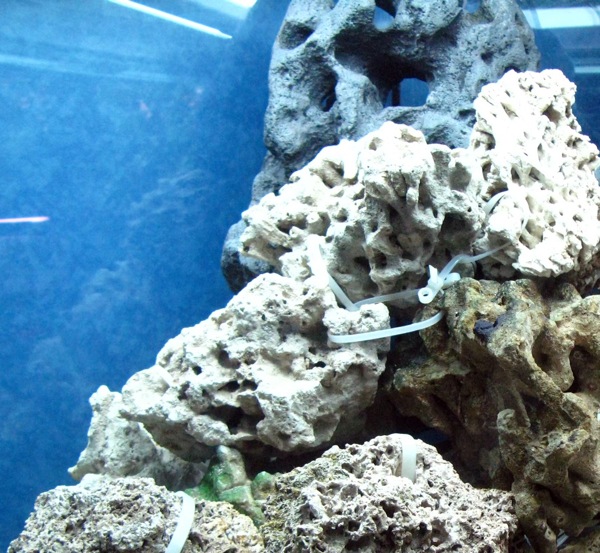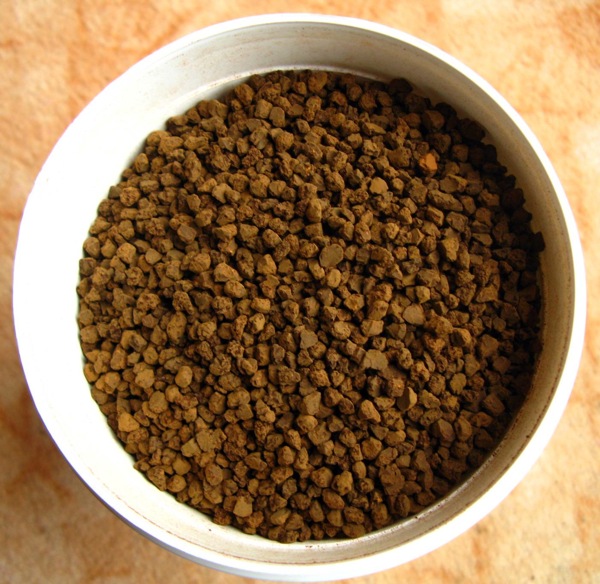|
|
Phosphates in Marine Aquarium
Systems
|
By Marco Lichtenberger |
What’s phosphate?
When talking about phosphate in aquariums, usually so called
orthophosphates are referred to. These are (mostly) negatively charged
ions containing phosphorus, oxygen and at least some of them hydrogen.
Other inorganic and organic forms of phosphates are ultimately turned
into orthophosphates by biochemical activities. These orthophosphates
are what is measured by most of the various phosphate testing kits
available in the stores. Phosphorus is contained in practically all
living organisms, but also in a number of common minerals like apatite
(Calcium phosphate). Phosphates can potentially be released from all
these phosphorus sources.
Desirable concentrations
Phosphates have two major influences on marine aquariums: Algae growth
(especially of the ones we don’t like looking at) can be promoted by
high levels of phosphates, and corals don’t react very well to high
phosphate levels (stunted growth, general decay).
The production of the calcareous skeleton of stony corals is
significantly inhibited by high phosphate levels, but most of the more
sensitive soft corals don’t react happily to high phosphate levels as
well. Therefore, such high concentration should be avoided. But how high
is high?
The water of natural coral reefs contains very little phosphate,
typically around 0.005 ppm, significantly lower levels can result in a
kind of coral bleaching (Tissue cannot regenerate anymore), so this
should be smallest desirable concentration.
Serious decrease of coral growth was detected at concentrations above
0.1 ppm. This can be considered ideally as the maximum level you should
have in your reef tank with stony corals. 0.25 should do if you only
have easy coral species, below 0.1 ppm seems mandatory for the more
sensitive ones.
While corals can react negatively to an increase of phosphates, fish
apparently are not affected. Whenever the fish are doing great, and the
corals are declining, it’s time to check the phosphate level of a tank.
Input: Common sources of phosphates
Saltwater
Both salt and water can be possible phosphate sources that should be
avoided simply by using commercial salt brands that don’t contain
phosphate, and by using RO or deionised water. Tap water may contain
amounts of phosphates fine for human consumption, but unhealthy for
corals. If you are unsure about the phosphate content of your water and
salt, you can use standard phosphate testing kits to check it prior to
and after mixing your saltwater.
Rocks and substrate
Dead reef rock (also referred to as base rock), tufa rock, but also
crushed coral substrate may contain serious amounts of phosphates. Some
is bound very tight (pretty dissoluble minerals), some may be dissolved
given the proper biochemical environment. If you want to know
approximately how much soluble phosphate is contained in a specific rock
or substrate, it is possible to test it in a bucket with heated and
moved salt water for some days. Contents of 1 mg phosphate per kilogram
of rock or crushed coral, and higher have been determined that way. A
tank in which such rock is used will have high phosphate concentrations
for a long time. If phosphate rich rock material is already in your
system, there are two possible solutions: Take out the rocks, or
increase the phosphate output of your system (see below).
The use of dead reef rock may be seen as one of the major sources of
long term high phosphates in marine aquariums. If they are used they
should be rinsed very well. Dead reef rock should also be scrubbed.
Proper bleaching may be necessary to remove some of the more soluble
phosphate containing agglomerations and minerals. Fresh and cured life
rock, however, has a much lower phosphate content and should be
preferred when setting up a new tank.
Frozen foods and thawing water
All foods used for fish and invertebrates contain phosphate (roughly
0.2-3% of its dry weight), but since you have to feed your animals, this
input cannot be decreased at first glance. What you can do is keep the
thawing water (that is not eaten anyway) out of the aquarium. Why all
that rinsing work?
The thawing water of various frozen foods has been analysed with regard
to its phosphate concentration (e.g. by Schwirtz). Contents between 0.74
mg/l (fish eggs thawed for 20 minutes) and 15.53 mg/l (mussel flesh
thawed for 2 hours) were measured in 100 ml of RO water, in which about
3 grams of frozen food were thawed. Accordingly, in a 100 gallon tank
fed with one un-rinsed 3 gram cube of mussel flesh the phosphate
concentration is being raised by 0.0039 mg/l per feeding only by the
thawing water. In 100 days without considering large water changes, this
would correspond to a phosphate concentration of 0.39 mg/l, a
concentration not healthy for corals, and the phosphates introduced by
the actual mussel flesh are not even considered in this example. So,
rinse your frozen foods!
Activated carbon
Steven Pro found that several samples of activated carbon intended for
aquarium use contained noticeable amounts of soluble phosphates. He used
50 ml of carbon and 250 ml of deionised water for his tests. The
phosphate concentrations detected may seem small considering the carbon
volume and water volume of a standard reef tank, but the frequent or
permanent use of activated carbon may be an additional phosphate source
that has to be considered, especially in the lower range of the
phosphate level desirable for a reef tank with difficult coral species.
Output: Removal of phosphates
Water changes
Phosphates, just as any other substances not existing in freshly mixed
saltwater, are removed by water changes. Changing 10% of water will
decrease the phosphate concentration ideally by 10%. However, if
phosphate reservoirs should exist in your tank, and your phosphate level
was in balance with these reservoirs prior to the water change, the
phosphate concentration may rise again in hours or days by formerly
precipitated phosphates dissolving again. Someday these reservoirs will
be exhausted (if output of phosphates is larger than input), but
depending on the system, this may take a long time and lots of water
changes.
Precipitation
An old, but still common technique of removing phosphates from the water
column is precipitating them as hard to dissolve minerals. Aside growth
of bacteria and plants (see below), this still is the most important
method used in large scale water cleaning systems like sewage plants.
It’s also the reason why the phosphate levels in the sea are very low:
Phosphates are precipitated especially in the vicinity of river mouths
where lots of iron containing sediments are transported into the ocean,
and the resulting minerals are buried in the sediments on the bottom of
the coastal waters.
Precipitation of phosphates in aquariums has one obvious danger: the
creation of new phosphate reservoirs. But how can such apparently
insoluble substances be dissolved again? Well, just the same way they
got precipitated: small and large scale changes in water chemistry (e.g.
lowering pH).
Imagine Calcium being used up by extensive coral growth: minerals
consisting of Calcium und phosphate (a discussed phosphate reservoir)
will be dissolved until the balance is restored. While Calcium is used
up again by further coral growth, the phosphates will mostly stay
dissolved in the water.
Next, imagine a partial water change: You’ll remove Calcium and
phosphate, which are in balance with a phosphate reservoir. The fresh
water only has Calcium, so again, phosphates can be dissolved and the
phosphate concentration will rise.
As a result, personally I prefer to remove phosphates once and for all
from tanks instead of precipitating and accumulating more and more
phosphate sediment. While these phosphate sediments are removed from
sewage plants with excavators and are possibly valuable to produce
fertilizer, this is difficult and messy in the aquarium, and can only
partially be accomplished by gravel vacuuming. To me precipitation is
not a long term solution.
 
Growth of macroalgae and animals
Every growing life will use up little amounts of phosphates. With each
fireworm, macroalgae, coral fragment etc. you take out of your tank,
you’ll remove some phosphate that was taken up during the growth of the
life form. Vice verse, everything that dies or is eaten will increase
the phosphate level of your tank.
Macroalgae, the most common life forms used to intentionally remove
phosphates (and nitrates) have been subject to studies examining their
phosphate (and nitrate) content. Caulerpa recemosa was found to contain
0.08% phosphorus (dry weight). That’s about 0.24% (ortho)phosphate. 1
gram of dried algae contains 2.4 mg phosphate. However, since wet algae
contain mostly water (up to 98%) you’d have to harvest at least 10 grams
to remove 2.4 mg phosphates from your tank. In a 100 gallon tank this is
a phosphate level drop of about 0.006 ppm (this amount of algae removal
corresponds to a decrease of the nitrate concentration by 0.06 ppm).
Removing phosphates by harvesting macroalgae or fast growing corals is
perfect for tanks with a relatively small input of phosphates, but this
method alone is usually not efficient enough to remove phosphates from
extensive feeding or polluted dead reef rock.
Growth of bacteria
Just like macroscopic life forms bacteria take up phosphates while
growing. But how do you remove their biomass from your system? There are
basically two possibilities: regularly rinsing biological filters like
bio-balls, zeolites and sponges, and skimming, which can remove entire
bacteria or parts of dead bacteria into a cup.
Similar to growth of higher life, bacteria growth can help you to keep
low phosphate concentrations down and stable, but it is mostly not
efficient enough to deal with high concentrations or phosphate
reservoirs.
Skimming
My own analysis of processed skimmate of a heavily fed tank revealed
nitrate concentrations of more than 200 ppm, which was about 20times the
concentration of the tank water. Phosphates, however, only showed twice
the concentration of the tank water, 1 ppm. So, this specific skimmer in
this specific setup was much more effective in removing nitrates (or to
be more exact: organic substances that were turned into nitrates by
bacteria) than it was in removing phosphates. Results of other tanks may
vary (the ones I tried so far were similar), but can easily be checked
by measuring nitrates and phosphates in skimmate. The skimmate should be
kept warm (25°C) and be aerated for about a night or longer to give the
bacteria a chance to turn proteins in the skimmate into measurable
substances (nitrates, phosphates).
Skimming can potentially help you to remove phosphates, but if you want
to know how much help it exactly provides, you have to analyse the
skimmate. For high phosphate values it is unlikely to be a very big help
(removed organics typically do not consist of very much phosphate), at
least I have yet to measure really high phosphate contents in skimmate.
Adsorbing media
The industry provides a number of phosphate adsorbing media (e.g.,
PhosGuard, Phosphate Remover, Phosphate Sponge, RowaPhos,
X-Phosphate,…), and the ones I tried worked as promised if applied as
recommended by the companies. The adsorbing media consist of aluminium
oxides and iron hydroxides specifically manufactured to have large
surfaces. Usually, the media is applied in a fluidised bed reactor or
simply in a very fine net at spot in the tank with medium current. On
the surfaces of the granules phosphates are bound (adsorbed). When the
surfaces are “full” and the concentration starts rising again, the media
and the bound phosphates are taken out of the aquarium. Using this media
is very helpful with any elevated phosphate level. The only danger with
this technique is to drop the phosphate concentration below the level
needed by corals for tissue regeneration. Therefore, it is important to
monitor the phosphate level during the use of adsorbing media. It is
also important to rinse the adsorbing media (preferably with RO water)
at least every few days to remove the thin layer of bacteria that builds
up around the grains and makes the media quickly ineffective by sealing
the surfaces.
Because organic molecules and some metals may potentially also be bound
to phosphate adsorbing media, and thus decrease its efficiency, it can
be recommended to use these media preferably after a few days of
filtration with activated carbon.
Since I work in the environmental field (e.g. projects about ground
water pollution), I’ve also tried iron hydroxides intended for large
scale phosphate removal from drinking water in aquariums and found them
to be just as effective as the aquarium products. However, I can only
recommend them to people, knowing exactly how to apply the products for
groundwater and drinking water treatment.
Adsorbing media are a good solution for high phosphates in tanks with
phosphate reservoirs from dead reef rock without having to remove the
rock from the aquarium. They are also especially helpful in tanks with
low to medium nitrates, but high phosphates, a situation that often
occurs in tanks with anaerobic, de-nitrifying filters like DSBs and
large fish. A definite minus is the high price these media command.
Control
Maintaining a healthy level of phosphates can be essential in a marine
aquarium. The phosphates in your tank are basically input minus output.
If you need to decrease the concentration, increase output and decrease
input. But, whatever you do, do it slow and aim for a long term balance.
Too fast drops of phosphates or drops below the level found in natural
seawater may instantly and permanently harm your corals.
References
Anja Schwirtz: Bestimmung der Phosphatmenge im Abtauwasser von diversen
Frostfuttersorten; http://www.aquacare.de/info/forsch/dla_phos.htm
(Determination of phosphate levels in the thawing water of various
frozen foods)
S. T. Larned: Nitrogen- versus phosphorus-limited growth and sources of
nutrients for coral reef macroalgae.- Marine Biology (1998) 132:
409-421.
http://www.botany.hawaii.edu/Bot482/Kaneohe%20Bay%20algae%20N-P%20Larned%20Mar%20Biol.pdf
Randy Holmes-Farley: Iron Oxide Hydroxide (GFO) Phosphate Binders.-
Reefkeeping 2004/11. http://reefkeeping.com/issues/2004-11/rhf/index.php
Randy Holmes-Farley: Chemistry and the aquarium – Aluminium in the reef
aquarium.- Advanced Aquarist 2003, July.
http://www.advancedaquarist.com/issues/july2003/chem.htm
Steven Pro: Activated carbon and phosphates. Conscientious aquarist vol.
4
http://www.wetwebmedia.com/ca/volume_4/V4I2/carbon/carbon_comparisons.htm
|
|




